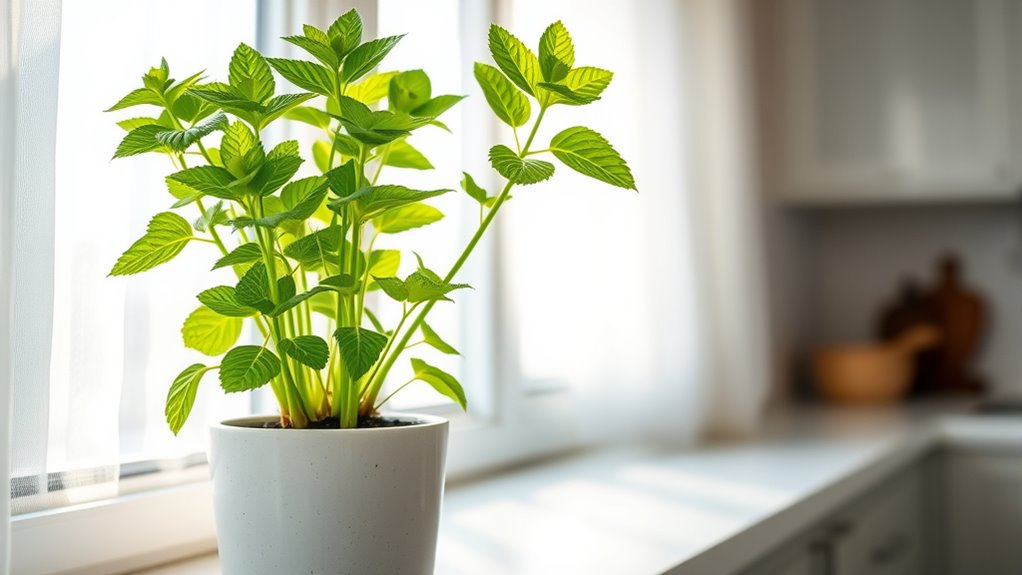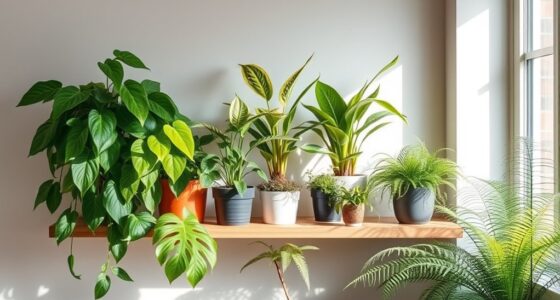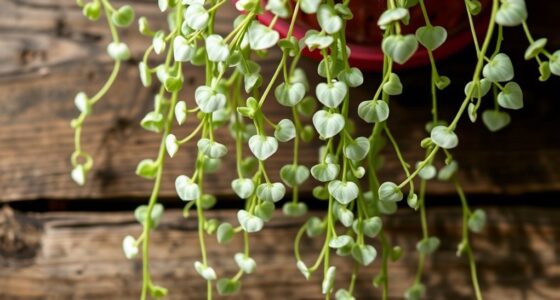To keep mint from taking over indoors, choose wide, shallow containers with good drainage and use well-draining potting mix. Prune regularly by pinching stems and removing flower buds to encourage bushiness and control growth. Place your mint in bright, indirect sunlight and water when the top inch of soil dries out. Select less invasive varieties like pineapple or orange mint, and consider planting each in its own pot for easier management. For more tips, continue exploring ways to master your indoor mint garden.
Key Takeaways
- Use wide, shallow containers with drainage holes and individual pots for each mint variety to prevent root spread.
- Regularly prune and remove flower buds to control size and redirect energy to foliage growth.
- Choose less invasive mint varieties like pineapple or orange mint for easier management indoors.
- Maintain consistent watering and ensure proper soil drainage to avoid soggy soil and root rot.
- Rotate plants regularly and manage light with grow lights or bright indirect sunlight to promote healthy, contained growth.
Choosing the Right Containers and Soil for Control
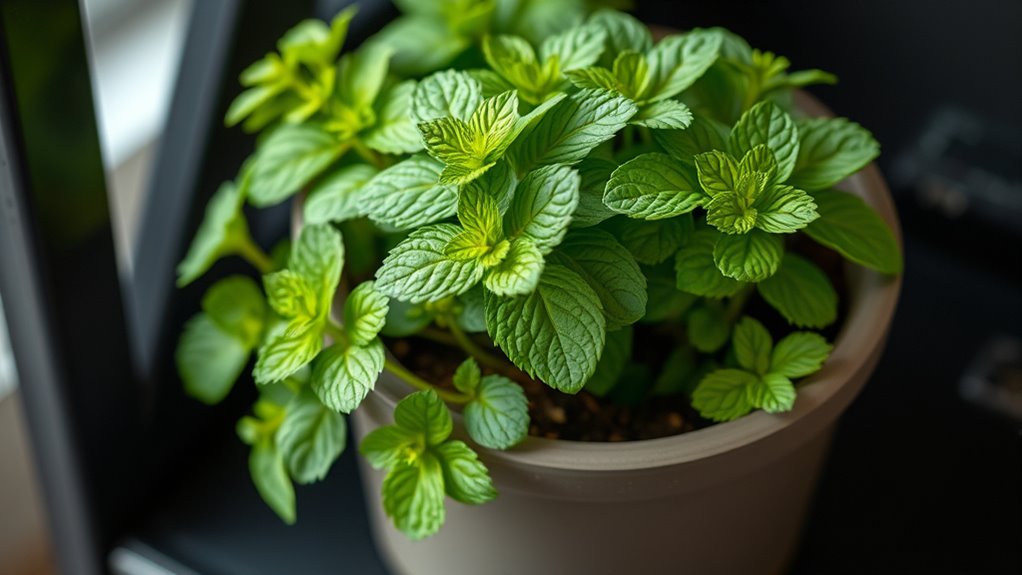
To keep your indoor mint manageable, choosing the right containers and soil is essential. Use containers with drainage holes at least 8 inches deep to prevent waterlogging and promote soil drainage. Proper soil storage techniques can help maintain the soil’s quality and prevent issues related to overwatering. Opt for wide, shallow pots instead of deep, narrow ones to help control root spread and restrict horizontal growth. Materials like plastic or glazed ceramic retain moisture better than porous clay or terracotta, helping limit overgrowth. Fill your container with high-quality, well-draining potting mix specifically designed for edibles to support healthy root development. Incorporating proper soil drainage techniques can significantly reduce the risk of overgrowth and help maintain your mint’s size. Additionally, selecting a container with adequate ventilation can promote healthier plant growth and prevent root rot. Choosing a container with drainage and the right soil ensures your mint stays contained and healthy, avoiding invasive growth.
Pruning and Harvesting Techniques to Manage Growth

Pruning and harvesting are effective ways to keep your indoor mint under control and promote healthy growth. Proper pruning encourages a bushier plant by pinching back stems just above leaf nodes, preventing it from becoming leggy. Removing flower buds promptly redirects energy toward leaf production, maintaining plant vitality. Additionally, understanding the growth patterns of mint can help you time your tuning techniques more effectively, ensuring your plant remains healthy and vigorous. Regular harvesting, ideally before flowering, keeps growth vigorous and prevents legginess. To do this effectively, use clean, sharp pruning shears to make precise cuts, reducing stress and disease risk. Staying aware of AI vulnerabilities can inform better plant management strategies, especially when relying on automated systems or smart gardening tools. As automation advances, it’s important to consider potential data privacy challenges that could affect smart gardening devices and applications. Here are key growth management tips: 1. Prune frequently to promote bushier growth. 2. Remove flower buds to focus energy on leaf production. 3. Adjust pruning intensity seasonally, with more aggressive trimming in spring.
Proper Watering and Lighting Practices
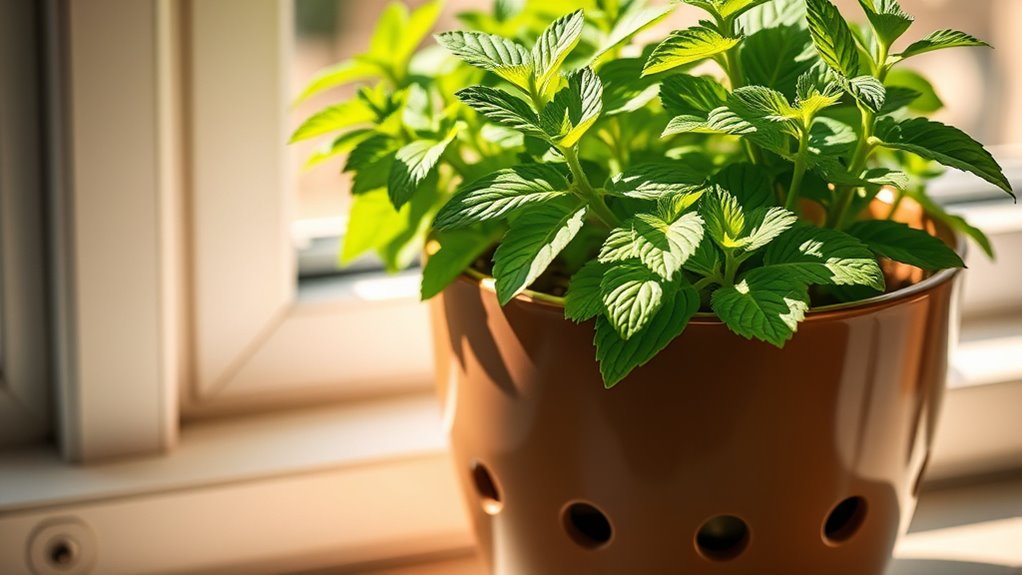
Ensuring your indoor mint receives proper watering and lighting is essential for healthy growth. Water your mint when the top inch of soil feels dry, typically once a week, to keep soil moisture consistent without overwatering. Use grow lights for 12-14 hours daily if natural sunlight is limited, providing adequate light exposure without harsh direct rays. Place your mint in bright, indirect sunlight—such as east or west-facing windows—to promote healthy growth and prevent legginess. Maintain proper drainage by ensuring excess water drains from the saucer, avoiding soggy soil that can cause root rot. Adjust your watering schedule based on growth conditions, and rotate the plant weekly to ensure even light exposure. Proper watering and lighting practices are key to keeping your mint healthy and manageable indoors. Additionally, understanding how contrast ratio impacts image quality can help you create an ideal environment for your plants by controlling light levels around your indoor garden. Creating an environment with optimal light spectrum can further improve your plant’s growth and health. Regularly monitoring soil moisture levels can help prevent overwatering and underwatering, ensuring your mint thrives, especially when combined with automation tools that can remind you when to water or adjust lighting.
Selecting Suitable Mint Varieties for Indoor Cultivation
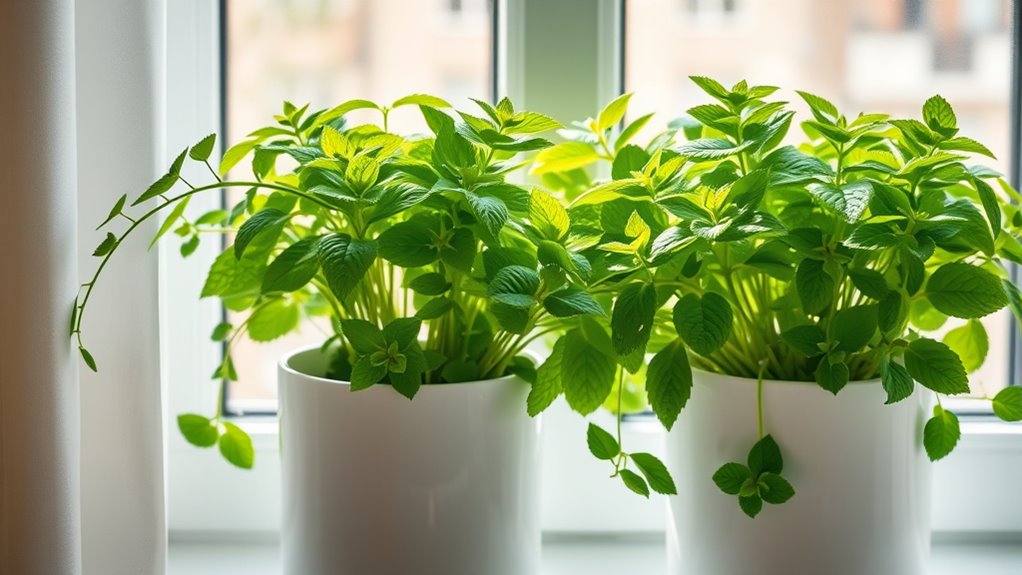
Choosing the right mint varieties for indoor growth can make a big difference in managing your plants. Opt for less invasive herbs like pineapple mint, apple mint, or orange mint, which tend to stay more contained. Tableware, with its emphasis on aesthetic appeal and functionality, highlights the importance of selecting plants that complement your indoor decor while remaining manageable. Select compact cultivars or those with naturally bushy growth habits to help with growth control in limited space. Using individual pots for each mint variety is essential for proper pot selection and preventing cross-contamination. Consider ornamental mint with variegated leaves, adding visual interest without risking overgrowth. Container gardening is an excellent way to keep mint contained and easily manageable. Additionally, choosing herbs with less aggressive growth habits can significantly reduce maintenance. Avoid aggressive types like peppermint and spearmint in shared containers, as they spread rapidly. These beginner-friendly herbs are perfect for container gardening, ensuring your indoor cultivation remains manageable and attractive without taking over your space. Proper plant selection based on growth behavior is crucial for maintaining an organized and healthy indoor herb garden. Incorporating Glycolic acid benefits in skincare routines can also improve skin health, making your overall environment more refreshing.
Implementing Spatial Strategies to Prevent Overgrowth

To effectively prevent your mint plants from overgrowing, implementing smart spatial strategies is essential. Use a wide, shallow container with good drainage to limit root spread and control plant size. Incorporate space management techniques to optimize growth and prevent crowding. Plant only one mint variety per container to prevent crossbreeding and aggressive overgrowth. Regular pruning and harvest encourage bushier growth while preventing the plant from becoming leggy. Incorporate root barriers or place your pot on saucers to restrict underground spreading. Choose an appropriately sized pot—too small can stunt growth, but too large can promote overgrowth. Selecting the right self watering plant pots can help maintain consistent moisture levels, promoting healthier roots and better growth control. Proper watering practices also help maintain healthy roots and prevent overgrowth. Understanding the growth habits of mint helps in designing effective containment strategies. Additionally, using container drainage effectively prevents waterlogging, which can lead to root rot and uncontrolled growth. These measures ensure your mint remains manageable and healthy without taking over your indoor space.
Frequently Asked Questions
How Do You Grow Mint Without It Taking Over?
To grow mint without it taking over, you should plant each variety in its own wide, shallow container with drainage holes.
Regularly prune and harvest the stems to keep the plant bushy and prevent legginess.
Use physical barriers or keep mint in pots inside decorative planters to contain its growth.
Avoid overwatering, and propagate from cuttings to maintain healthy, contained plants that won’t spread uncontrollably.
Why Is My Mint Dying Indoors?
Think of your indoor mint like a lively guest at a party—if overfed or overstayed, it suffers. Your mint might die because you’re overwatering, which drowns roots like a flood, or because it’s not getting enough light, leaving it pale and leggy.
Poor drainage, drafts, or too much fertilizer also stress your plant. To revive it, guarantee proper watering, good light, and stable conditions.
How to Eradicate Invasive Mint?
To eradicate invasive mint, start by removing all visible stems and roots from the ground or container. Use a sharp tool to dig out any underground runners, making sure to get every fragment.
Consistently prune new shoots and runners to prevent regrowth. Consider applying a natural weed killer or placing a physical barrier around the area to block root expansion.
Regularly monitor and repeat these steps until the mint is fully eradicated.
Does the Mint Plant Take Over?
You wonder if mint takes over, and the answer is yes, it can. Its vigorous roots spread quickly, overtaking space and crowding out other plants.
To prevent this, you should use wide, deep containers with drainage, prune regularly to keep it bushy, and choose less invasive varieties.
Conclusion
Believe it or not, keeping mint indoors under control is entirely possible with the right techniques. By choosing the right containers, pruning regularly, and providing proper watering and lighting, you can enjoy fresh mint without it taking over. Some say mint will always spread—yet, with these strategies, you can prove that theory wrong. Stay vigilant, and you’ll have manageable, fragrant mint that enhances your space without becoming a household invasion.
